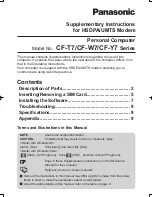
7
BOSCH PERFORMANCE LINE
Bicycle Owner’s Manual
7
▸ Handlebar ends: Make sure the handlebar grips are
secure and in good condition, with no cuts, tears, or worn
out areas. If not, have your dealer replace them. Make
sure the handlebar ends and extensions are plugged. If
not, have your dealer plug them before you ride. If the
handlebars have bar end extensions, make sure they are
clamped tight enough so you can’t twist them.
WARNING: Loose or damaged handlebar grips or
extensions can cause you to lose control and fall.
Unplugged handlebars or extensions can cut you and
cause serious injury in an otherwise minor accident.
VERY IMPORTANT SAFETY NOTE:
Please also read and become thoroughly familiar with
the important information on the lifespan of your bicycle
and its components in Appendix B on Page 28.
D. First ride
When you buckle on your helmet and go for your first
familiarization ride on your new bicycle, be sure to pick
a controlled environment, away from cars, other cyclists,
obstacles or other hazards. Ride to become familiar with
the controls, features and performance of your new bike.
Familiarize yourself with the braking action of the bike
(see Section 4.C). Make yourself familiar which levers
activates which brake, right/left, front/rear. Test the
brakes at slow speed, putting your weight toward the rear
and gently applying the brakes, rear brake first. Sudden
or excessive application of the front brake could pitch you
over the handlebars. Applying brakes too hard can lock up
a wheel, which could cause you to lose control and fall.
Skidding is an example of what can happen when a wheel
locks up.
If your bicycle has toeclips or clipless pedals, practice
getting in and out of the pedals. See paragraph B.4 above
and Section 4.E.4.
If your bike has suspension, familiarize yourself with
how the suspension responds to brake application and
rider weight shifts. See paragraph B.6 above and Section
4.F.
Practice shifting the gears (see Section 4.D). Remember
to never move the shifter while pedaling backward,
nor pedal backwards immediately after having moved
the shifter. This could jam the chain and cause serious
damage to the bicycle.
Check out the handling and response of the bike; and
check the comfort.
If you have any questions, or if you feel anything about
the bike is not as it should be, consult your dealer before
you ride again.
it looks when you know the tires are correctly inflated;
and adjust if necessary.
▸ Tires in good shape? Spin each wheel slowly and look
for cuts in the tread and sidewall. Replace damaged tires
before riding the bike.
▸ Wheels true? Spin each wheel and check for brake
clearance and side-to-side wobble. If a wheel wobbles
side to side even slightly, or rubs against or hits the brake
pads, take the bike to a qualified bike shop to have the
wheel trued.
CAUTION: Wheels must be true for rim brakes to
work effectively. Wheel trueing is a skill which
requires special tools and experience. Do not
attempt to true a wheel unless you have the knowledge,
experience and tools needed to do the job correctly.
▸ Wheel rims clean and undamaged? Make sure the
rims are clean and undamaged at the tire bead and, if you
have rim brakes, along the braking surface. Check to make
sure that any rim wear indicator marking is not or still
visible at any point on the wheel rim depending on the
type of wear indicator used on your bike.
WARNING: Bicycle wheel rims are subject to wear.
Ask your dealer about wheel rim wear. Some wheel
rims have a rim wear indicator which becomes
visible or disappears as the rim’s braking surface wears. A
visible rim wear indicator on the side of the wheel rim is
an indication that the wheel rim has reached its maximum
usable life. Riding a wheel that is at the end of its usable
life can result in wheel failure, which can cause you to
loose control and fall.
▸ Brakes: Check the brakes for proper operation (see
Section 4.C). Squeeze the brake levers. Are the brake
quick-releases closed? All control cables seated and
securely engaged? If you have rim brakes, do the brake
pads contact the wheel rim squarely and make full contact
with the rim? Do the brakes begin to engage within
an inch of brake lever movement? Can you apply full
braking force at the levers without having them touch the
handlebar? If not, your brakes need adjustment. Do not
ride the bike until the brakes are properly adjusted by a
professional bicycle mechanic.
▸ Wheel retention system: Make sure the front and rear
wheels are correctly secured. See Section 4.A
▸ Seat post: If your seat post has an over-center cam
action fastener for easy height adjustment, check that it is
properly adjusted and in the locked position. See Section
4.B.
▸ Handlebar and saddle alignment: Make sure the
saddle and handlebar stem are parallel to the bike’s
center line and clamped tight enough so that you can’t
twist them out of alignment. See Sections 3.B and 3.C.








































